The NVIDIA GeForce GTX 1070 Ti Founders Edition Review: GP104 Comes in Threes
by Nate Oh on November 2, 2017 9:00 AM EST- Posted in
- GPUs
- GeForce
- NVIDIA
- Pascal
- GTX 1070 Ti
Overclocking
As NVIDIA is pushing the GTX 1070 Ti for overclocking, it is only fair that we look into it. While NVIDIA does support overclocking, they have limited actual overvolting, and instead providing the ability to unlock 1-2 more boost bins and associated voltages. Using Precision XOC, we adjusted the core and memory clocks, as well as the power/temperature limit and percent 'overvoltage.' For the 180W GTX 1070 Ti, the TDP and TDP limit match the GTX 1080, resulting in a 120% power limit (216W). The 1.093v boost voltage is no surprise, matching the GTX 1080 and 1070 FEs.
| GTX 1070 Ti FE Overclocking | ||||
| Stock | Overclocked | |||
| Core Clock | 1607MHz | 1787MHz | ||
| Boost Clock | 1683MHz | 1863MHz | ||
| Max Boost Clock | 1898MHz | 2078MHz | ||
| Memory Clock | 8Gbps | 8.8Gbps | ||
| Max Voltage | 1.062v | 1.093v | ||
The results, of course, cannot be taken as representative of all GTX 1070 Ti Founders Editions, as this is only a sampled sample size of one. But results here can offer some insight. For one, if there were explicit actual overvolting, it seems very possible to stabilize ~2100+MHz clocks on the GTX 1070 Ti Founders Edition. At any rate, GPU overclocks topped out with observed clocks in the high 2000MHz region, roughly 10% over the previously measured average in-game clockspeeds. Memory overclocks were only able to go up 200MHz from the base 2002MHz, or also about 10%. All-in-all, very similar to the GTX 1070 FE, which also managed 10% overclocks on both GPU and GDDR5 memory. Recalling that the GTX 1070 Ti FE clocked on average just 2% higher than the GTX 1070 FE at stock, there's nothing particularly groundbreaking here, especially considering the 20-25% overclock capability of Maxwell 2 reference cards.
A total of four different overclocks were tested. First was a baseline, consisting of 100% overvoltage and max power/temperature limits. The second was overclocking the GDDR5 memory by 800Mbps. The third was overclocking the GPU with a +180MHz offset; in practice this resulted in observed clocks between 2030 - 2080MHz. Lastly, all previous adjustments were combined for an overall overclock.
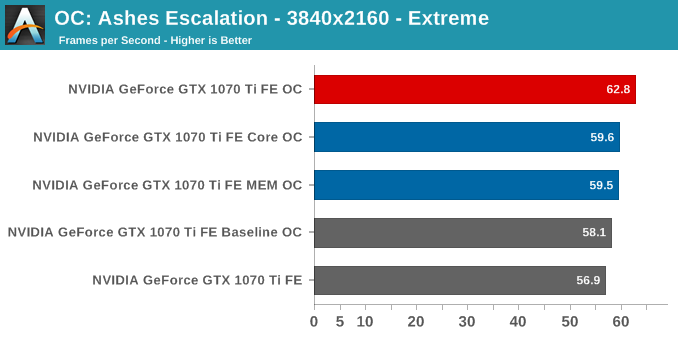
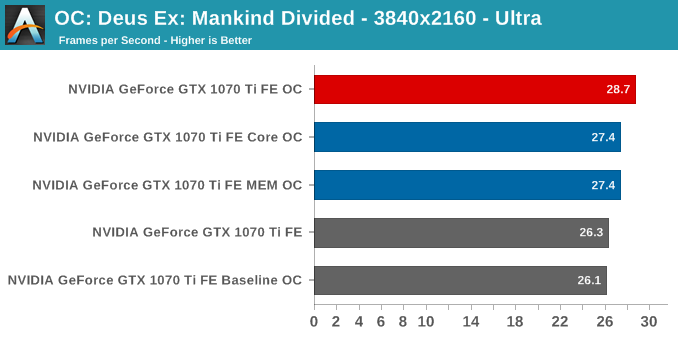
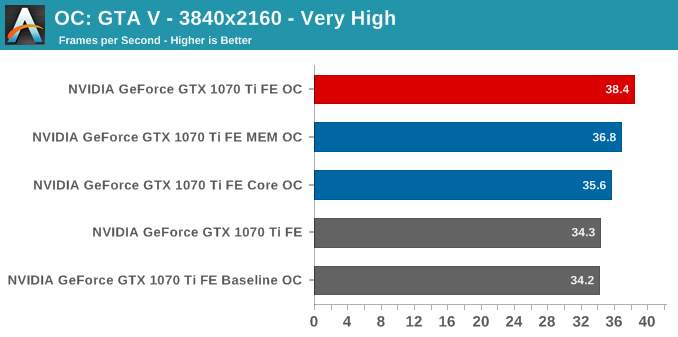
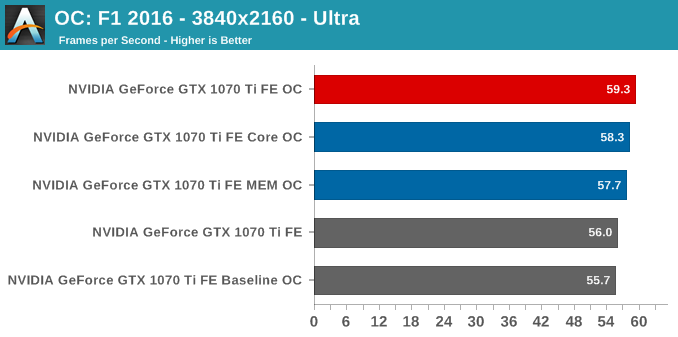
Although this is more of a cursory look than anything else, the combined overclock provides the best performance, just like it was for the GTX 1080 and 1070, although it seems like memory overclocking is more effective on the GTX 1070 Ti. Earlier, we mentioned how the GTX 1070 Ti compared to the GTX 1070 by having four more SMs but without any additional memory bandwidth, and perhaps that is playing a role here.
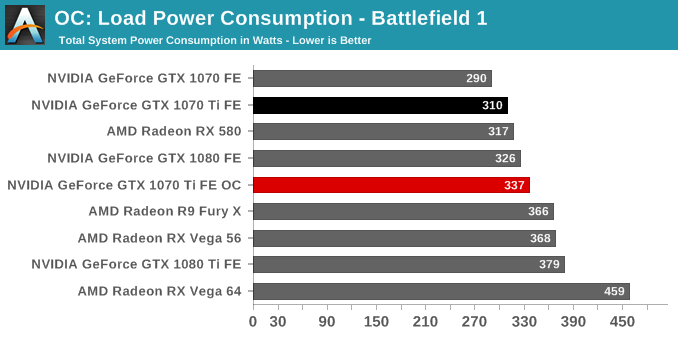
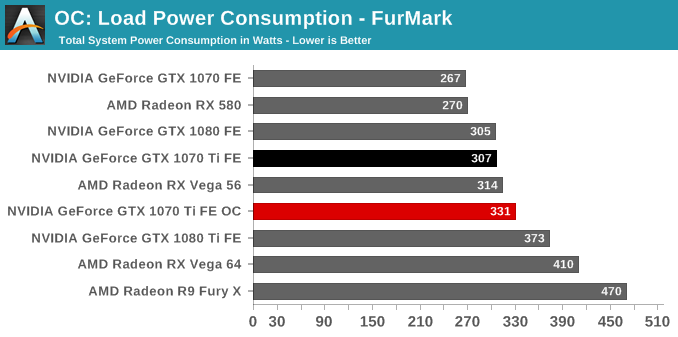
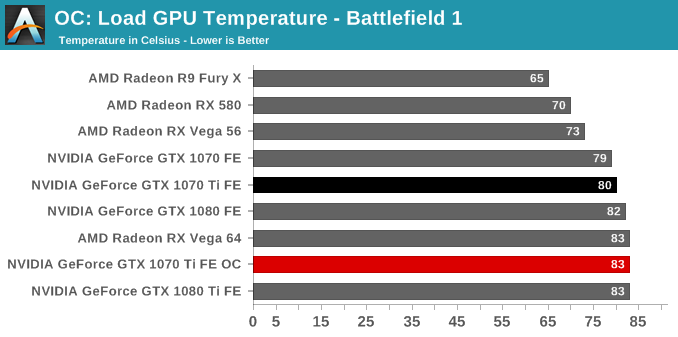
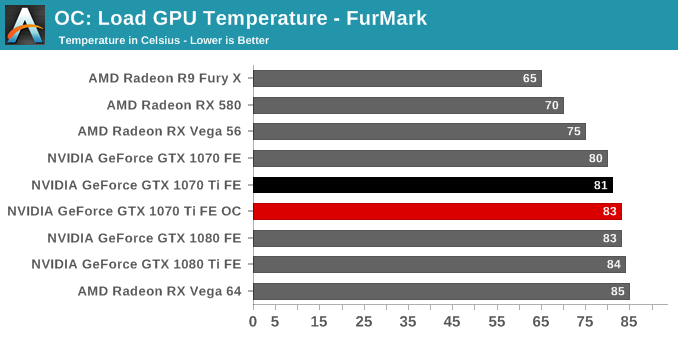
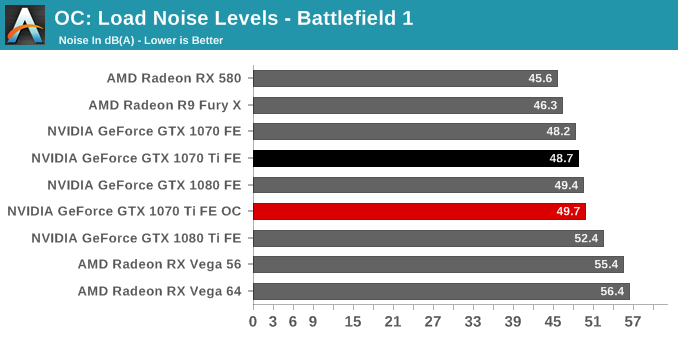
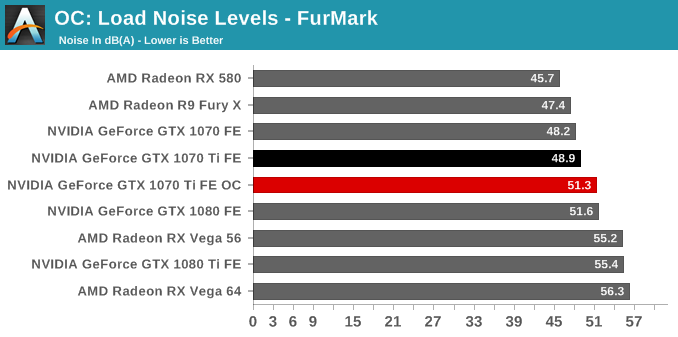
There isn't much to add on the power, temperature, and noise front. Understandably, the card will heat up a few more degrees and spin its blower faster, at the expense of ~25W at the wall, inasmuch as the 120% power limit will let it. As a casual overclocker, there may not be a lot to gain here; the GTX 1070 Ti FE already boosts to ~1800+MHz at stock, and squeezing 200MHz more with the anemic capabilities of NVIDIA's reference PCB won't make waves. And for hardcore overclockers, there would be little need of the reference board's power delivery system.










78 Comments
View All Comments
Nfarce - Friday, November 3, 2017 - link
"Vega 56 beats 1070 in almost all games."It beats the reference GTX 1070, but a factory overclocked 1070 pulls ahead again, especially overclocked on top of the factory overclock. Vega 56 (or 64 for that matter) does not have that type of overclocking headroom. This has long been an advantage for Nvidia. AMD GPUs have a history of being terrible overclockers. My old EVGA GTX 970 SSC ACX 2.0+ could be overclocked to 980 performance without even touching the voltage for example.
LastQuark - Saturday, November 4, 2017 - link
Vega 56 BIOS can be upgraded to the Vega 64 BIOS for another 20% speed boost. Vega can only do 5% max. With Vega 56 lower price point by over $50, cheaper Freesync monitor options, and 2x the availability of GSync, Vega 56 is still making a lot of sense for new buyers.B-Real - Thursday, November 2, 2017 - link
According to this theory, you can't compare the 1070 to the Vega56, as the 1070 is 5 degrees Celsius hotter...damonlynch - Thursday, November 2, 2017 - link
It should be "nonetheless", not "none the less", in the introduction to the Final Words ;-)jardows2 - Thursday, November 2, 2017 - link
Good showing. At MSRP, a good argument (from these tests at least) can still be made for Vega 56. Not sure if 1070ti is worth $50.00 more, but you do get a little bit better performance, and most important to me, a lower noise profile at load. Keeping it interesting for sure!CaedenV - Thursday, November 2, 2017 - link
So.... it is essentially a direct Vega 56 competitor except that it will be available on store shelves for purchase?Really hoping that this will cause the normal 1070 prices to drop a bit *fingers crossed*. I picked up a 4k monitor last year and my gaming has been quite limited on it with my GTX 960. A 1070 will fill in quite nicely for now, and next year when the new cards come out I'll pick up a 2nd 1070 for SLi to really make 4K gaming smooth.
BrokenCrayons - Thursday, November 2, 2017 - link
SLI doesn't seem like a good solution these days given tepid support from the GPU manufacturers and very few modern titles that are optimized to take advantage of a 2nd graphics card. You might have a better experience if you set aside the first 1070's cost until next year and then use the funding from both to purchase a 1080 or just hang on to see what happens with Volta since there'll likely be consumer GPUs available sometime in 2018.vladx - Thursday, November 2, 2017 - link
AMD has no chance at all, a RX Vega 56 in my country is $150 more expensive than the newly released GTX 1070 Ti.Sorjal - Thursday, November 2, 2017 - link
Easiest check to see potential mining impact is toss a ti and non in a pc and test with some miner program. Nicehash legacy is probably the best for comparative stats. Run their benchmark on both cards on precise and compare the results. There will be some variance, but it should provide a decent reference. Nvidias are typically used on ones that are more gpu intensive, with Zcash probably the largest. AMD works off their bandwidth and are favored for corresponding currencies like Etherium and Monero. The nice hash legacy will test against most of the major ones including Ethereum, Monero, and ZCash.Given the increased CPU performance, it is probably being tested mining wise as we speak
Sorjal - Thursday, November 2, 2017 - link
Remember to overclock and undervolt. Energy effeciency is a large factor. 1070's seem to be run between 65-70% power limit. A voltage meter on the outlet may be useful in this case as you can look at the voltage change for each test for each card